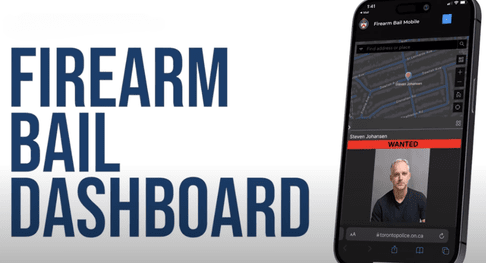


Bail Dashboard
Bail Dashboard
The Firearm Bail Dashboard is an inter-agency collaboration to share firearm and bail compliance data in real-time between police agencies that started in 2022. The Durham Regional Police Service (DRPS) and the Toronto Police Service (TPS) developed and launched the dashboard to share and display each other’s bail offender information on internal dashboards. Since it launched, the Ontario Provincial Police and Ottawa Police have joined the dashboard, with other services expected to onboard in 2024.
This innovative approach, the first of its kind in Canada, enhances officer and community safety. The data also gives frontline officers access to real-time situation awareness. In 2022, there were approximately 203 bail offenders displayed on the dashboard with more than 600 checks done between the launch date of July 7 (when the dashboard began) and December 31.

By November of 2022, 227 subjects were on the Firearm Bail Dashboard. By July 2023, one year into the project, 440 subjects were on the Bail Compliance Dashboard as of July 2023. As of March 2024, 555 subjects on the Bail Compliance Dashboard.
Since the introduction of the Firearm Bail Dashboard, DRPS has observed an increase in the number of bail compliance checks conducted by officers in the community each year. Bail compliance checks play a crucial role in community safety by ensuring that individuals awaiting trial adhere to their court-ordered release conditions.
Bail compliance check totals:
- 2021: 1127
- 2022: 1688 (dashboard launched in July 2022)
- 2023: 3339
Body- Worn Cameras
Body- Worn Cameras
DRPS began a phased deployment of body-worn cameras (BWC) in the fall of 2021. By 2023, all front-line officers were equipped with one of the devices, with more than 565 BWCs being distributed.
Body-worn cameras provide an unbiased, independent account of police/community interactions. The Durham Regional Police Services Board and Durham Regional Police Service are committed to delivering accountable and transparent policing services. Body-worn Camera footage provides valuable insight that can legitimize officer-public interactions, provide evidence in court, or offer an unbiased alternative to allegations of misconduct.
In 2023, there were 222,172 body-worn camera videos recorded, compared to 129,977 in 2022.
Automatic License Plate Recognition (ALPR)
Automatic License Plate Recognition (ALPR)
DRPS is leveraging the power of technology to enhance roadway safety in the region with the deployment of Automated Licence Plate Readers (ALPR) that started in spring 2023. ALPRs are camera systems that automatically capture images of all licence plates within the camera’s scanning range. The system continuously scans licence plates that will alert officers to any “hits” on a hotlist (stolen plates and vehicles, plates registered to suspended drivers (including impaireds, expired permits, and other offences). The system will also notify officers of missing and wanted persons and vehicles associated to AMBER alerts.
Data Informed Policing
Data Informed Policing
DRPS recognizes the importance of proactive and directed patrol strategies to ensure public safety, deter criminal activities and foster community trust.
Real-time data visualization, reporting and dashboards provide DRPS with tools to understand operational trends, support community safety and strengthen the bond between the Service and the community.
Ensuring evidence-based approaches that are collaborative, measured and evaluated as well as supported through adopting the best tools, enhanced training and clear governance will lead to better outcomes for our community.
Enhanced reporting to the community
Enhanced reporting to the community
The Monthly Crime and Traffic dashboard is now available on the DRPS website. The data represented on the dashboard and heat maps include data related to overall service calls, violent crime, property crime and traffic services. It was designed to provide citizens with an overview of police activity and should not be used to make decisions or comparisons regarding the safety or crime levels for a specific area.
Previous Story
Next Story





